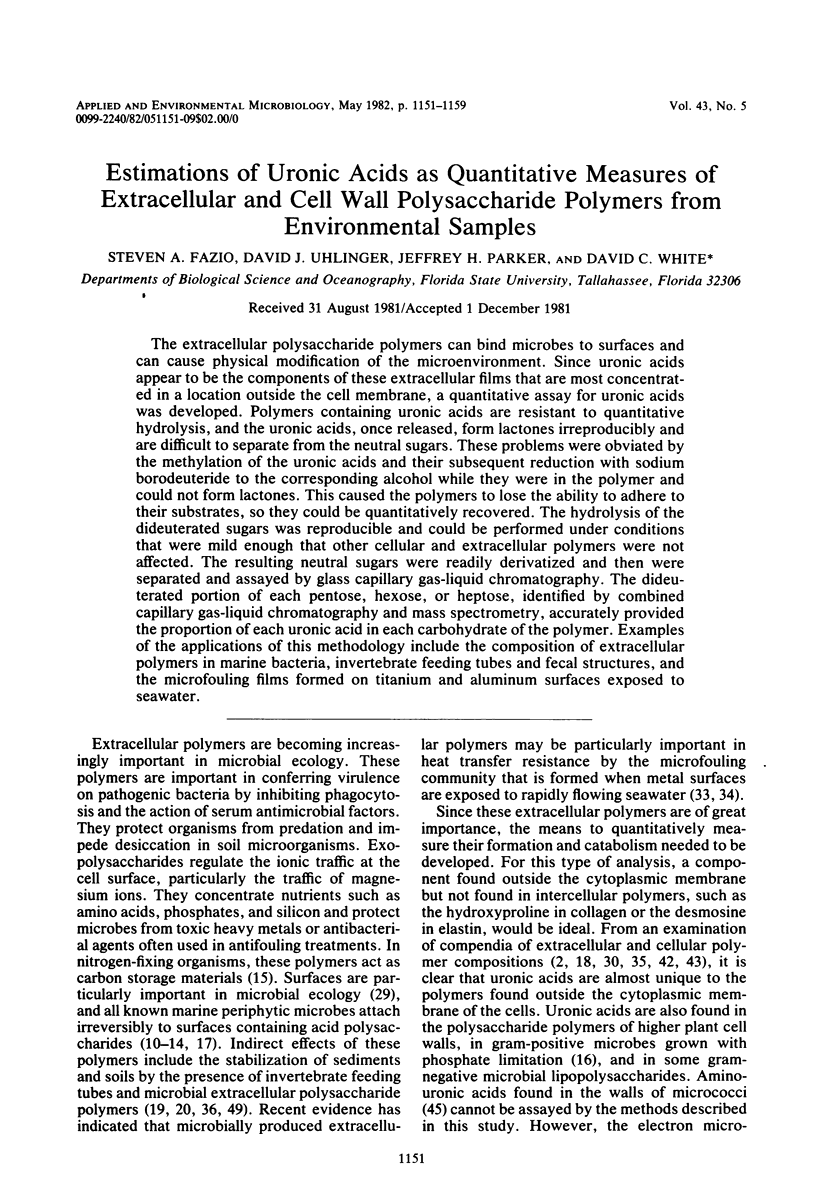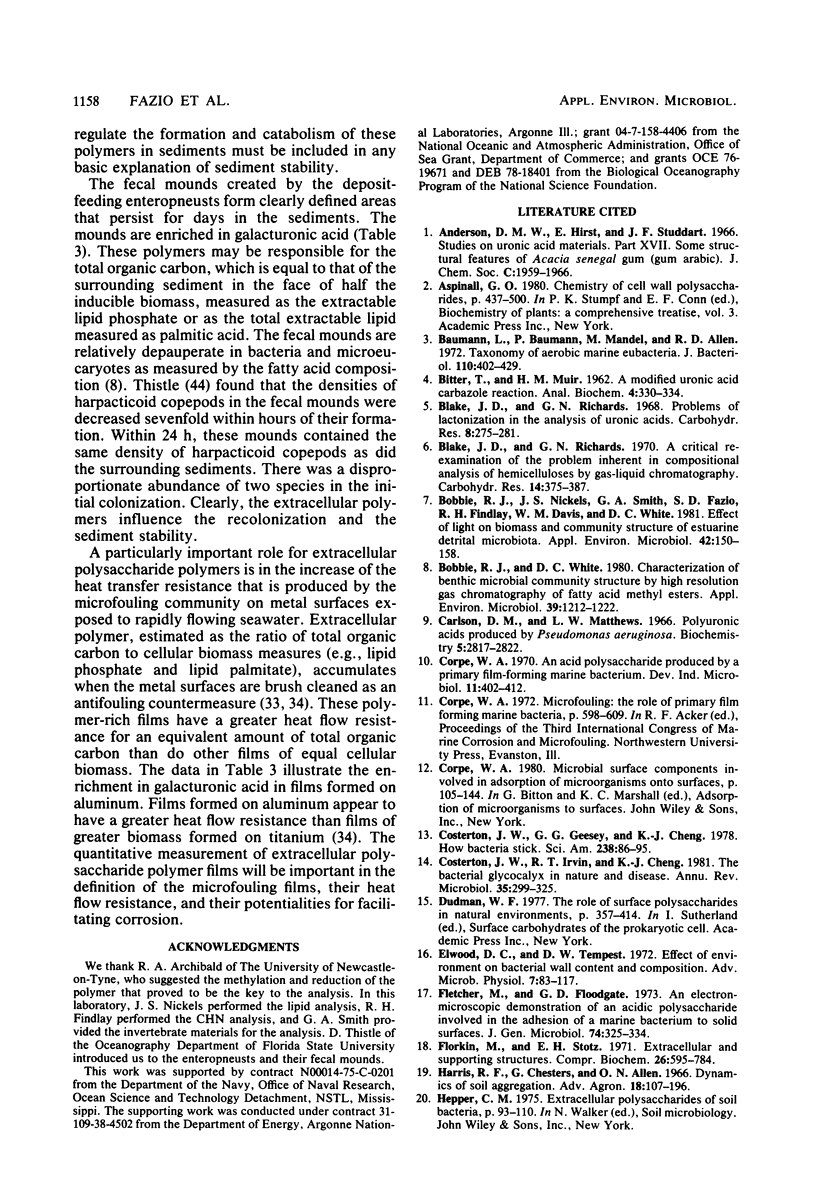Abstract
The extracellular polysaccharide polymers can bind microbes to surfaces and can cause physical modification of the microenvironment. Since uronic acids appear to be the components of these extracellular films that are most concentrated in a location outside the cell membrane, a quantitative assay for uronic acids was developed. Polymers containing uronic acids are resistant to quantitative hydrolysis, and the uronic acids, once released, form lactones irreproducibly and are difficult to separate from the neutral sugars. These problems were obviated by the methylation of the uronic acids and their subsequent reduction with sodium borodeuteride to the corresponding alcohol while they were in the polymer and could not form lactones. This caused the polymers to lose the ability to adhere to their substrates, so they could be quantitatively recovered. The hydrolysis of the dideuterated sugars was reproducible and could be performed under conditions that were mild enough that other cellular and extracellular polymers were not affected. The resulting neutral sugars were readily derivatized and then were separated and assayed by glass capillary gas-liquid chromatography. The dideuterated portion of each pentose, hexose, or heptose, identified by combined capillary gas-liquid chromatography and mass spectrometry, accurately provided the proportion of each uronic acid in each carbohydrate of the polymer. Examples of the applications of this methodology include the composition of extracellular polymers in marine bacteria, invertebrate feeding tubes and fecal structures, and the microfouling films formed on titanium and aluminum surfaces exposed to seawater.
Full text
PDF








Selected References
These references are in PubMed. This may not be the complete list of references from this article.
- BITTER T., MUIR H. M. A modified uronic acid carbazole reaction. Anal Biochem. 1962 Oct;4:330–334. doi: 10.1016/0003-2697(62)90095-7. [DOI] [PubMed] [Google Scholar]
- Baumann L., Baumann P., Mandel M., Allen R. D. Taxonomy of aerobic marine eubacteria. J Bacteriol. 1972 Apr;110(1):402–429. doi: 10.1128/jb.110.1.402-429.1972. [DOI] [PMC free article] [PubMed] [Google Scholar]
- Bobbie R. J., Nickels J. S., Smith G. A., Fazio S. D., Findlay R. H., Davis W. M., White D. C. Effect of light on biomass and community structure of estuarine detrital microbiota. Appl Environ Microbiol. 1981 Jul;42(1):150–158. doi: 10.1128/aem.42.1.150-158.1981. [DOI] [PMC free article] [PubMed] [Google Scholar]
- Bobbie R. J., White D. C. Characterization of benthic microbial community structure by high-resolution gas chromatography of Fatty Acid methyl esters. Appl Environ Microbiol. 1980 Jun;39(6):1212–1222. doi: 10.1128/aem.39.6.1212-1222.1980. [DOI] [PMC free article] [PubMed] [Google Scholar]
- Carlson D. M., Matthews L. W. Polyuronic acids produced by Pseudomonas aeruginosa. Biochemistry. 1966 Sep;5(9):2817–2822. doi: 10.1021/bi00873a006. [DOI] [PubMed] [Google Scholar]
- Costerton J. W., Geesey G. G., Cheng K. J. How bacteria stick. Sci Am. 1978 Jan;238(1):86–95. doi: 10.1038/scientificamerican0178-86. [DOI] [PubMed] [Google Scholar]
- Costerton J. W., Irvin R. T., Cheng K. J. The bacterial glycocalyx in nature and disease. Annu Rev Microbiol. 1981;35:299–324. doi: 10.1146/annurev.mi.35.100181.001503. [DOI] [PubMed] [Google Scholar]
- Inoue S. The determination of iduronic acid and glucuronic acid in heparins by a new technique. Re-evaluation of the variable hexuronic acid composition of mammalian heparins. Biochim Biophys Acta. 1973 Dec 5;329(2):264–270. doi: 10.1016/0304-4165(73)90291-2. [DOI] [PubMed] [Google Scholar]
- Jones T. M., Albersheim P. A gas chromatographic method for the determination of aldose and uronic Acid constituents of plant cell wall polysaccharides. Plant Physiol. 1972 Jun;49(6):926–936. doi: 10.1104/pp.49.6.926. [DOI] [PMC free article] [PubMed] [Google Scholar]
- Linker A., Jones R. S. A new polysaccharide resembling alginic acid isolated from pseudomonads. J Biol Chem. 1966 Aug 25;241(16):3845–3851. [PubMed] [Google Scholar]
- MARKOVITZ A. Method for the selection of bacteria that synthesize uronic acid-containing polysaccharides. J Bacteriol. 1961 Sep;82:436–441. doi: 10.1128/jb.82.3.436-441.1961. [DOI] [PMC free article] [PubMed] [Google Scholar]
- Mathews M. B. Macromolecular evolution of connective tissue. Biol Rev Camb Philos Soc. 1967 Nov;42(4):499–551. doi: 10.1111/j.1469-185x.1967.tb01528.x. [DOI] [PubMed] [Google Scholar]
- Nickels J. S., Bobbie R. J., Lott D. F., Martz R. F., Benson P. H., White D. C. Effect of manual brush cleaning on biomass and community structure of microfouling film formed on aluminum and titanium surfaces exposed to rapidly flowing seawater. Appl Environ Microbiol. 1981 Jun;41(6):1442–1453. doi: 10.1128/aem.41.6.1442-1453.1981. [DOI] [PMC free article] [PubMed] [Google Scholar]
- Selvendran R. R., March J. F., Ring S. G. Determination of aldoses and uronic acid content of vegetable fiber. Anal Biochem. 1979 Jul 15;96(2):282–292. doi: 10.1016/0003-2697(79)90583-9. [DOI] [PubMed] [Google Scholar]
- Smith E. J. Purification and properties of an acidic polysaccharide isolated from Achromobacter georgiopolitanum. J Biol Chem. 1968 Oct 10;243(19):5139–5144. [PubMed] [Google Scholar]
- Sutherland I. W. Bacterial exopolysaccharides. Adv Microb Physiol. 1972;8:143–213. doi: 10.1016/s0065-2911(08)60190-3. [DOI] [PubMed] [Google Scholar]
- Ward J. B. Teichoic and teichuronic acids: biosynthesis, assembly, and location. Microbiol Rev. 1981 Jun;45(2):211–243. doi: 10.1128/mr.45.2.211-243.1981. [DOI] [PMC free article] [PubMed] [Google Scholar]
- Williams A. G., Wimpenny J. W. Exopolysaccharide production by Pseudomonas NCIB11264 grown in continuous culture. J Gen Microbiol. 1978 Jan;104(1):47–57. doi: 10.1099/00221287-104-1-47. [DOI] [PubMed] [Google Scholar]


